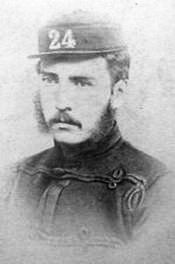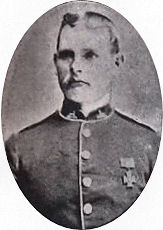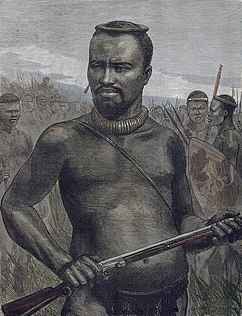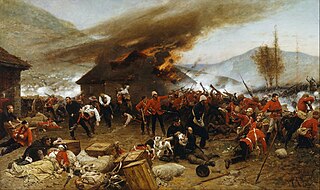
The Anglo-Zulu War was fought in 1879 between the British Empire and the Zulu Kingdom. Following Lord Carnarvon's successful introduction of federation in Canada, it was thought that similar political effort, coupled with military campaigns, might succeed with the African kingdoms, tribal areas and Boer republics in South Africa. In 1874, Sir Henry Bartle Frere was sent to South Africa as High Commissioner for the British Empire to bring such plans into being. Among the obstacles were the presence of the independent states of the South African Republic and the Kingdom of Zululand and its army.

Isandlwana is an isolated hill in the KwaZulu-Natal province of South Africa. It is located 105 miles (169 km) north by northwest of Durban. The name is said to mean abomasum, the second stomach of the cow, because it reminded the Zulus of its shape.

The Battle of Isandlwana on 22 January 1879 was the first major encounter in the Anglo–Zulu War between the British Empire and the Zulu Kingdom. Eleven days after the British commenced their invasion of Zululand in South Africa, a Zulu force of some 20,000 warriors attacked a portion of the British main column consisting of about 1,800 British, colonial and native troops and perhaps 400 civilians. The Zulus were equipped mainly with the traditional assegai iron spears and cow-hide shields, but also had a number of muskets and old rifles. The British and colonial troops were armed with the modern Martini-Henry breech-loading rifle and two 7-pounder mountain guns deployed as field guns, as well as a Hale rocket battery. Despite a vast disadvantage in weapons technology, the Zulus ultimately overwhelmed the British, killing over 1,300 troops, including all those out on the forward firing line. The Zulu army suffered anywhere from 1,000 to 2,500 killed.

William Jones was a British recipient of the Victoria Cross for his action at the Battle of Rorke's Drift in January 1879, the highest and most prestigious award for gallantry in the face of the enemy that can be awarded to British and Commonwealth forces.

Zulu is a 1964 British epic war film depicting the Battle of Rorke's Drift between the British Army and the Zulus in January 1879, during the Anglo-Zulu War. It depicts 150 British soldiers, many of whom were sick and wounded patients in a field hospital, who successfully held off a force of 4,000 Zulu warriors. The film is notable for showing the Zulu army as disciplined and governed by strategy.

Major Gonville Bromhead VC was a British Army officer and recipient of the Victoria Cross, the highest award for gallantry in the face of the enemy that can be awarded to members of the British armed forces. He received the medal for his part in the defence of Rorke's Drift in January 1879 where a small British garrison of 139 soldiers successfully repulsed an assault by some 4,000 Zulu warriors. Bromhead was portrayed by Michael Caine in the film Zulu, which depicted the battle.

Colonel John Rouse Merriott Chard was a British Army officer who received the Victoria Cross, the highest military decoration for valour "in the face of the enemy" that can be awarded to members of the British armed forces. He earned the decoration for his role in the defence of Rorke's Drift in January 1879 where he commanded a small British garrison of 139 soldiers that successfully repulsed an assault by some 3,000 to 4,000 Zulu warriors. The battle was recreated in the film Zulu in which Chard was portrayed by Stanley Baker.

Christian Ferdinand Schiess VC was a Swiss recipient of the Victoria Cross, the highest and most prestigious award for gallantry in the face of the enemy that can be awarded to British and Commonwealth forces. He died in poverty at just 28.

James Langley Dalton VC was an English recipient of the Victoria Cross, the highest and most prestigious award for gallantry in the face of the enemy that can be awarded to British and Commonwealth forces for service at the Battle of Rorke's Drift during the Anglo-Zulu War.

Alfred Henry "Harry" Hook VC was an English recipient of the Victoria Cross, the highest and most prestigious award for gallantry in the face of the enemy that can be awarded to British and Commonwealth forces, for his actions at the Battle of Rorke's Drift.

Robert Jones VC was a Welsh recipient of the Victoria Cross for his actions at the Battle of Rorke's Drift in January 1879, the highest and most prestigious award for gallantry in the face of the enemy that can be awarded to British and Commonwealth forces.

'Padre' George Smith, Army Chaplain, was a defender of Rorke's Drift during the Zulu War of 1879, an action which saw the winning of eleven Victoria Crosses.
Rorke is a surname that may refer to:

Major General Sir Harcourt Mortimer Bengough joined the British Army in 1855, and retired in 1899, after more than forty years of distinguished service from the Crimea to all quarters of the Empire.

Dabulamanzi kaMpande was a Zulu commander in the Anglo-Zulu War, most noted for commanding the Zulus at the Battle of Rorke's Drift. He was a half-brother of the Zulu king Cetshwayo kaMpande.
Rorke's Drift Art and Craft Centre is a center for arts and crafts, including fine art, printmaking, pottery and weaving, located in KwaZulu-Natal, South Africa. It has been described as "the most famous indigenous art centre in South Africa".
Colonel Henry Thomas Curling was a Royal Artillery officer of the British Army who served between 1868 and 1902. He fought in the Anglo-Zulu war and during the Battle of Isandlwana was one of only a few British officers to survive; in fact he was the only British front line survivor. Afterwards he wrote a dramatic report on the battle and several letters home that described it further. After the Zulu war he saw service in Afghanistan, Aldershot and Egypt. The letters he wrote during the Zulu war were posthumously published in the book The Curling letters of the Zulu War: "there was an awful slaughter" (2001) co-authored by Adrian Greaves and Brian Best.

Private Thomas Collins of Pelcomb, Camrose in the county of Pembrokeshire, Wales was a participant in the battle of Rorke's Drift which took place 22-23 January 1879. During this battle, the 24th regiment of foot fought and resisted a force of at least 4,500 Zulu warriors leaving 17 British dead and 10 wounded, along with 450 dead Zulu warriors.

The Defence of Rorke's Drift is an 1880 painting by Elizabeth Thompson, Lady Butler depicting the 1879 Battle of Rorke's Drift which took place during the Anglo-Zulu War of 1877 to 1879. The battle and the men who fought in it were made famous in the 1964 film Zulu.


















